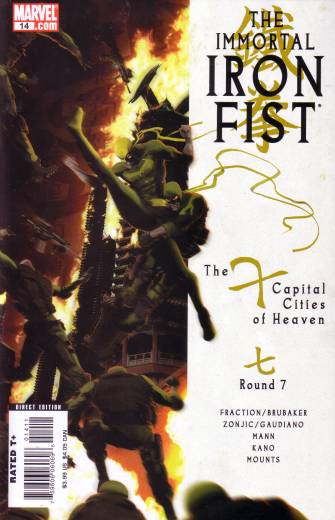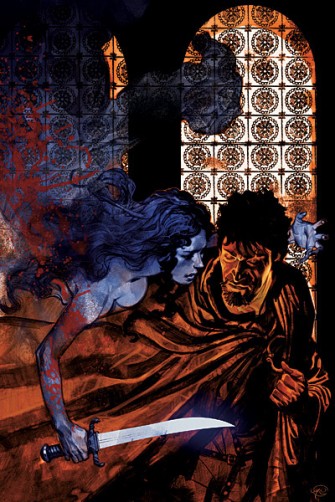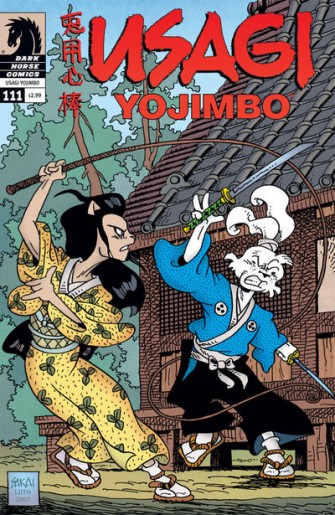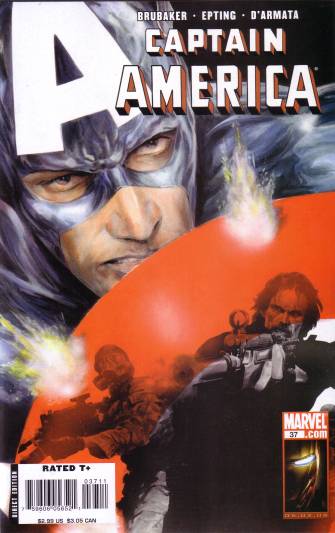
May 12, 2008
 A Thought Or Two On The Notion Of Comic Books Costing Too Darn Much
A Thought Or Two On The Notion Of Comic Books Costing Too Darn Much






Let's talk comic books. On Thursday, I bought the above comics and paid almost $19 for the pleasure. The total was slightly shocking to me, because five comics still feels in the hand -- my hand -- like a $10 purchase. Truth is, five comic books hasn't been a $10 purchase for a long time. I knew that, and I didn't know that, if you know what I mean. In my defense, I rarely buy comics and when I do, it's usually one or two as a courtesy to the store I just spent a half-hour casing or a couple hundred dollars' worth around the holidays from
Chuck Rozanski or
Buddy Saunders. I like all of the comics I purchased Thursday, but for maybe the first time in my entire life of buying comics, I experienced a twinge of regret as the $20 left my hand. "I probably could have spent
that twenty bucks more effectively," I thought.
I've always been loathe to throw my lot in with the crowd that constantly yells, posts and cavils that comic books cost too much. They remind me of those people that complain about gas prices but drive everywhere they possibly can in giant sports-utility vehicles. I suspect that for a lot of those people it's not that comics cost too much as much as comics no longer are as cost-effective to enjoy in the very specific way they demand to enjoy them. I tend to be more of a mind with people like
Jeff Smith, who's argued in the past -- and if I'm misremembering this, please consider the substance of the argument without the pedigree -- that comics have value as a permanent, perpetual resource for entertainment that buttresses the temporary nature of that first, sweet read. And yet if I'm honest with my own reaction to the way things have progressed, I have to admit that maybe there are points on both sides of the argument.

Jeff Smith's comics in serial form are indeed worth their cover price, largely because, well, he's Jeff Smith. His comics are well-designed, strongly executed and in his life's work to date,
Bone, they were part of a propulsive narrative serial of the kind that greatly rewards an interactive installment plan. But let me state the obvious: most comics aren't like Jeff Smith's. Most comics aren't that well executed nor are they as attractively designed nor are they always part of a focused serial that flatters the format. Even the best serial comics only approach those standards occasionally, it seems, in between larger segments where nothing very much at all happens and what happens doesn't happen in a way that's memorable. Serial comics readers remember the good runs for decades afterward, and I think live in partial denial about the dominance of the fallow periods. Because the issues sell at least some copies no matter what, because comics doesn't really have a system where a terrible comic book will sell 10,000 copies one issue after selling 100,000 copies even though the newer issue might
deserve to sell that poorly, the system and its aggressive pricing mechanisms stay in place and will remain there for the foreseeable future.
Another source of imbalance, I think, is that the newer, higher prices put a strain on the consumer in a way that cheaper comics did not, partly because of the nature of that consumer. (I don't know how exactly the inflation works out, and I'm not sure that it matters as much as the perception and reaching a perceived tipping point, but calculators like
this one suggest prices almost 3X ahead of inflation since 1981.) The fragmentary nature of American comic books post-1980 encourages the purchase of a wide array of comics, an experience where the consumer finds satisfaction across several titles in part because it's missing at any one time in a single series. This isn't a strict rule, and I'm certain there's someone out there that only ever buys comic books with Black Bolt, for instance. I'd strongly suggest that the weight of anecdotal evidence indicates the thrust of that description is true. Surely the average, desirable, expected comics customer since the early '80s -- the person that pops to mind when someone says "comics reader" -- is a person that buys a number of comics instead of just one or two. Here's the thing: the price of serial comics right now makes sense for the reader that only buys one or two comics. It makes much less sense, almost no sense, for the consumer that buys the number of comics most knowledgeable people would gut-reaction say marks an average fan's consumption level.

This mismatch of price point and assumed primary experience practically guarantees a constant winnowing of the core fan base into smaller and smaller numbers, those that can handle and will endorse the spending of whatever X-amount of dollars that seems to be the required entry point for full-bore, quality readership. One of many, many reasons manga has been successful is that it not only seems to connote value on a one on one basis -- a manga trade vs. a comic book -- but that the perceived value works according to a standard model of participation. A lot of folks seem to feel that buying x-amount of dollars in manga has a better chance to give you a more rewarding experience than buying x-amount of dollars in American comic books. They have a point. Throw in the lack of discipline ingrained in the North American Direct Market model -- the mysterious way these books come out, the stacking of certain titles on certain weeks, the lack of guarantees regarding creators and the related notion that a book may not even continue if the creative team simply decides not to follow through -- and it's a wonder that anyone, even a tremendously skilled and resourceful buyer, continues to adhere to that debilitating consumer relationship.
It's clear why the publishers that effectively produce serial comics stay the course: serial comics can be hugely profitable, or at the very least constitute a key part of a lucrative publishing cycle. If nothing else, serial publication provides multiple opportunities for publicity and marketing. Serial comics is a growing market for a few major publishers, showing signs of healthy sales beyond the top five or ten all the way down the line. Moreover, there's a sense, I think, that certain serial comics may continue to sell at a profit no matter how high the prices rise -- as long as they don't rise too quickly. Publishers and retailers may talk about killing the golden goose by making them too expensive or through other poor publishing habits, but that the goose is golden seems understood. Heck, we already know a lot of comics will sell at least a moderate amount no matter how frequently or for how long they fall into a creative stupor. The system is so effective in moving a big chunk of comics at prices that push the limits of good sense that efforts to provide an alternative to this sales pattern are looked upon with distrust and scorn. For instance, some retailers see a comic priced to sell at a lower point to a different stratum of fan not as a unique business model with its own positives and negatives but as a rebuke to the current system and a lost opportunity to maximize the amount of cash a comic book with that title's level of appeal might generate.
A big danger, I think, is not that serial comics becomes a market that's wholly unprofitable. Mind you, this has already happened for certain actors in that marketplace. In case you missed it, maybe
the best-selling alternative comic in history in an aggregate sense
abandons the comic book ship this year. I'm also at a loss to name a half-dozen hit independent comic books since 1993. Still, what seems to me a more likely outcome is that the comic book market becomes a market that fails even more spectacularly to realize its long-term potential and further risks not being able to provide its unique value to the wider world of comics. The serial comics market of a generation past set the groundwork for the current, ongoing, vital groundswell of trades and graphic novels by allowing a wide variety of creators an opportunity to hone their craft over time and a large number of readers a chance to follow and understand and sample them over the same amount of time without great risk, nurturing a love for the form as well as for individual books. I owe much of the breadth of my comics reading habits to the ability to try out new comics at a cheap price, and I bet that's true of a lot of readers ten years on either side of my age.

That market has been replaced by a half-virtual marketplace that may allow one to sample or read some comics without purchase, may bury other comics outright, and all the time hounds the reader to make one more purchase in their comfort zone. It's a market that can be outright hostile to new work that doesn't look a lot like other comics in the top slots. The fact that a
Buffy the Vampire Slayer comic book can break into the Diamond top ten doesn't seem to me as important as the certainty we will never return to an historical moment when a significant number of creator-owned books could sell 6500 or 9000 or 12000 copies, you could count on their presence in most major markets, and creators had a chance -- only a chance -- to build the beginnings of a career interacting with a readership multiple times a year over a several-year period, all without having to earn back an advance. I would argue it's more important to the general health of the art form
and the industry that the next Jeff Smith be able to generate 30,000 in comic book sales than it is that Marvel moves 130,000 units with Stephen King's name on them. I'm not sure the
existing Jeff Smith gets to that sales point without some struggle. And I don't think it's as easy as the on-line comic replacing the serial comic as the entry point; that's a seismic shift in culture and in the nature of the reading experience for me to believe it does exactly the same thing. In fact, I would argue that as a group the current on-line comics models come closer to encouraging a medium more like comic books in the 1940s than comics in the 1960s or 1980s.
I once wrote that the only comic book that was too expensive was a bad comic book, and I think that's true as far as it goes. But I also think that a market that allows us to experience not-great comic books is part of what makes most of us better, more passionate readers, and a significant part of what provides the marketplace with the great talents of tomorrow. Do comic books cost too much? Yes. They're too expensive to facilitate a multi-level, satisfying buying experience -- the experience that structurally they cultivate -- for all but a declining few. The squeezing of profits through elements like pricing that outpaces inflation leads to an ossified marketplace that has come dangerously close to fully abandoning its role as the fertile, chaotic creative ground that feeds the medium entire. I'll take it all back if in 10 years the sons and daughters of the bookstore and the free comic on-line can boast of as many great cartoonists in their generation as the Direct Market babies are now able to point to in theirs, and if they have as many readers who know and care enough about their medium of choice to make an eloquent case on those artists' behalf. As is the case with so many things in life, we may only find out what we're missing when it's gone.
posted 11:00 am PST |
Permalink
Daily Blog Archives
November 2019
October 2019
September 2019
August 2019
July 2019
Full Archives


